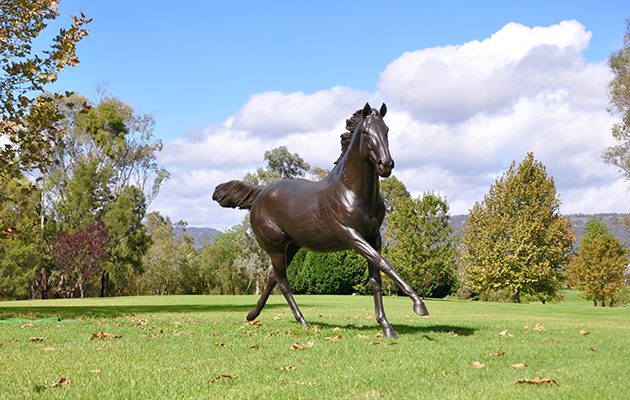Capturing the power and beauty of the horse is the challenge sculptor Charlie Langton has set himself, as he explains to Janet Menzies
A fascination with horses started at a very young age for Charlie Langton. Now he captures their beauty and power in life-size sculptures, as Janet Menzies discovers.
For more sporting artists, Simon Ryder is on a year-long mission and you can get involved. And The Monarch of the Glen by Sir Edwin Landseer has been secured for Scotland.
CHARLIE LANGTON
From Leonardo da Vinci to any Pony Clubbing 10-year-old, there is something about the horse that compels us to try to capture its unique form and unquantifiable beauty. I’m surprised my teachers were ever able to decipher my homework amidst the obsessive failed studies of pasterns and flexed hocks that decorated the margins. Charlie Langton’s images of horses are rather more on the Leonardo lines but he is gripped by the same bug. “I grew up around horses and I used to have this little Welsh mountain pony called Whizz who was the worst behaved but I would spend all summer mucking around with him.

A bronze of Giant’s Causeway at Ashford Stud, Kentucky.
“I find horses fascinating to look at. They are a balance of power and beauty. Their physical make-up is quite extraordinary and they are inspiring to watch. I used to doodle horses the whole time. I wasn’t a massive fan of riding, it was all about observing the horses and drawing them. I remember doing my first full oil painting of a horse when I was 11 or 12. I enjoyed the structure of the cheekbone and then trying to get the warmth into the eyes. They are not easy to draw but once you get it right you know because it all seems to click. Their physical structure is a challenge – horses are this amazing combination of speed, power and delicacy.”
It is the age-old paradox of the horse, that an animal weighing around half a ton, capable of running at 30mph, clearing six foot or pulling a carriage is supported on the equine equivalent of four human finger nails. Sculpture, especially life-size and greater-than-life-size bronzes, was to be Langton’s solution to depicting this conundrum. The racing world is familiar with his figures of Kauto Star, Giant’s Causeway, Goldikova, Yeats and others at racecourses and studs, and his work has been exhibited at London’s Sladmore Gallery and the Rountree Tryon.
For HM The Queen’s 90th birthday, Newmarket commissioned Langton to make a 20%-over-life-size bronze of the monarch, which shows her with the mare, Highclere, and a foal. The resulting piece can be seen on Birdcage Walk, Newmarket, and shows an extraordinary tenderness and connection between all three figures.

Mare and Foal, the over-life-size sculpture created for HM The Queen’s 90th birthday, now on Birdcage Walk, Newmarket.
As his work develops, it seems Langton has discovered another layer to the enigma of the horse. “It is the deeper layer that, as humans, we are able to put so much trust into something so big and powerful,” he explains. That trust is usually reciprocated by the horse, which works voluntarily alongside its human colleagues, even allowing us to take the lead in decision making. Langton agrees: “I am trying to embody that connection that we have with horses – it’s hard to understand it until you’ve had that experience yourself. I think it is an amazing relationship. When I’m working on a bronze I spend a lot of time with the horse because I want to understand its character as well as its physical attributes, really just as a portrait painter would have sittings with a human subject.
“It’s quite demanding. Taking the horse’s physical measurements isn’t always straightforward – some don’t like it. Then, in the studio, I will make an armature at one-quarter of life size, with the head in one-third life size. The scaling has to be absolutely precise, because any mistakes will be magnified later in the process. The next element is taking this up to the life-size clay model that I will spend four or five months sculpting. Luckily, I have a large studio so I can stand back and get a long view of the model, which is really important. I am trying to be accurate in showing the horse’s type – its physical character. At first the work is quite blocky and then you start refining and refining, especially the portrait of the head.”

Langton working on Pegasus.
When Langton is satisfied, the heavy lifting starts, literally, as the sculpture goes to the Sculpture Castings foundry at Basingstoke for the complex process of casting into bronze. Langton explains: “The casting is done in cases in sections. There are usually three for the body and two for each leg and so on. Then the sections are re-assembled, welded and chased. It has to be really precise, because if one angle is even millimetres out it will throw out the whole sculpture.”
Eventually, after around a year in the making, the finished sculpture is ready – in about the same time as it takes a mare to produce the real thing.
Charlie Langton’s bronzes can be seen at racecourses and studs in England and worldwide. For more details on these and his other work, visit: charlielangtonart.com





